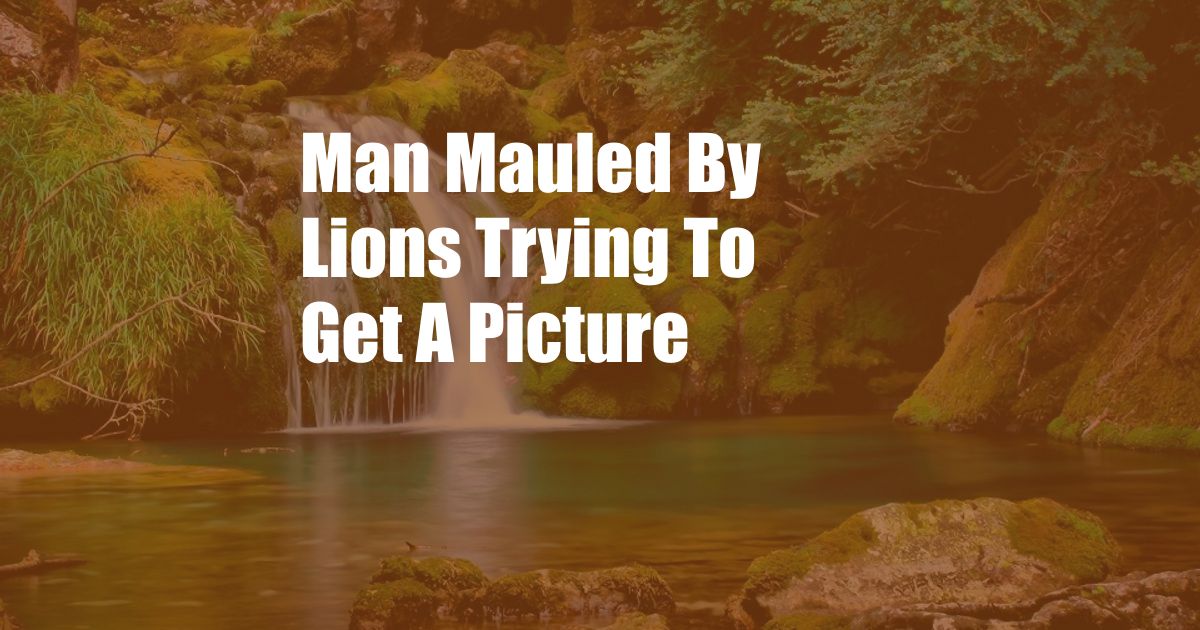
Man Mauled by Lions While Attempting to Capture a Photo
In a heart-stopping incident that serves as a stark reminder of nature’s unpredictable power, a man was severely injured after being mauled by a pride of lions while attempting to photograph them. The victim, identified as Stuart Wem, was on a safari tour in South Africa’s renowned Kruger National Park when the tragic event occurred.
As Wem approached a group of lions, he reportedly left the designated viewing area in pursuit of a closer shot. This reckless act agitated the animals, causing them to charge at him. Wem was swiftly knocked to the ground and subjected to a horrific mauling, sustaining severe lacerations and puncture wounds.
Wildlife Photography: A Balancing Act of Curiosity and Caution
Wildlife photography, a thrilling and increasingly popular pursuit, carries inherent risks that demand utmost respect and caution. While the allure of capturing breathtaking images drives photographers to venture into the wild, it’s imperative to prioritize safety and abide by established guidelines to avoid such unfortunate incidents.
The Kruger National Park, home to an abundance of diverse wildlife, enforces strict regulations to ensure the well-being of both animals and visitors. These regulations include designated viewing areas that serve as safe zones for observing wildlife from a reasonable distance, minimizing the risk of encounters.
Understanding Lion Behavior: A Key to Safe Encounters
Lions, apex predators with formidable strength and hunting instincts, are highly territorial and protective of their space. They perceive close proximity as a threat, which can trigger their defensive responses. Understanding their natural behavior is crucial for photographers seeking to capture their essence while maintaining a respectful distance.
Experts emphasize the importance of observing lions from a safe distance, using telephoto lenses to achieve the desired perspective. Additionally, sudden movements or loud noises can spook these magnificent creatures, potentially eliciting an aggressive reaction. By respecting their boundaries and observing from afar, photographers can minimize the likelihood of dangerous encounters.
Tips for Responsible Wildlife Photography: Striking a Harmony Between Observation and Respect
1. Remain in Designated Areas: Always adhere to designated viewing areas, providing a safe buffer between you and wildlife.
2. Maintain a Distance: Use telephoto lenses to capture images from a safe distance, avoiding any actions that might be perceived as threatening.
3. Avoid Disturbing Wildlife: Refrain from making sudden movements, using flash photography, or making noises that may startle animals.
4. Respect Territorial Boundaries: Observe lions from a distance, respecting their territorial instincts and avoiding any attempts to approach them.
5. Be Aware of Your Surroundings: Pay attention to animal behavior and environmental cues to anticipate any potential risks.
A Call to Action: Embracing Responsible Wildlife Photography
The incident involving Stuart Wem serves as a poignant reminder of the importance of responsible wildlife photography. By adhering to established guidelines and respecting animal boundaries, photographers can capture stunning images while upholding ethical standards and preserving the well-being of wildlife.
As a community of nature enthusiasts, we must collectively advocate for responsible wildlife photography practices, promoting a harmonious coexistence between humans and the awe-inspiring creatures we share this planet with.
FAQ on Man Mauled by Lions Incident
Q: Where did the incident take place?
A: Kruger National Park, South Africa.
Q: What prompted the lion attack?
A: The victim left the designated viewing area to take a closer picture.
Q: What type of injuries did the victim sustain?
A: Severe lacerations and puncture wounds.
Q: What regulations are in place at Kruger National Park regarding wildlife photography?
A: Designated viewing areas and prohibited actions to minimize risks for both animals and visitors.
Q: What lessons can be learned from this incident?
A: Respecting wildlife boundaries and adhering to safety guidelines is paramount for responsible wildlife photography.